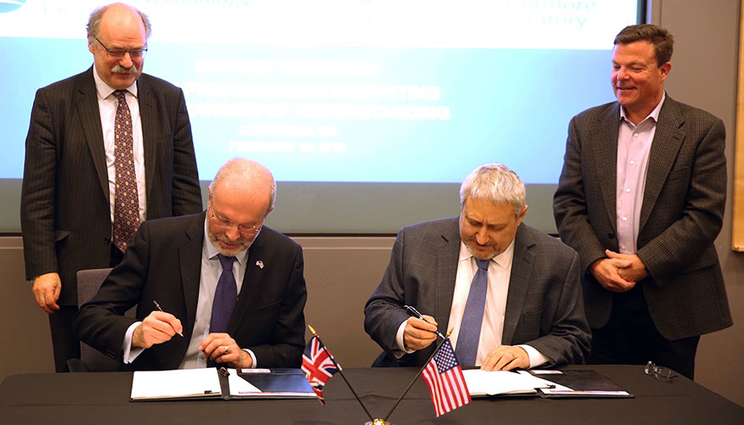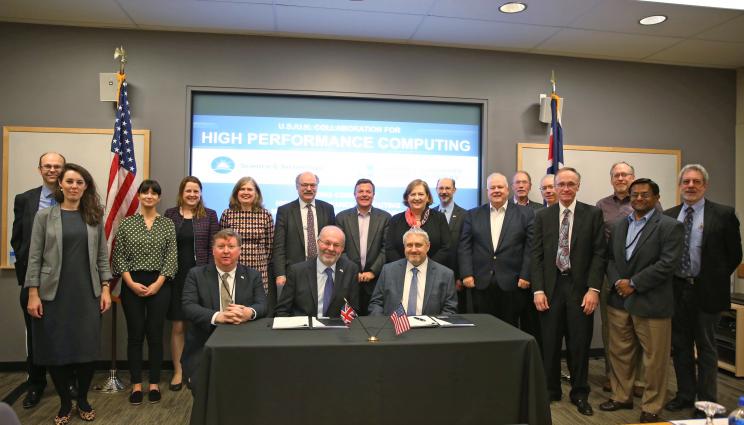LLNL/U.K. officials ink agreement to collaborate on HPC research, ensure competitiveness
 (Download Image)
Lawrence Livermore National Laboratory Director Bill Goldstein (right foreground) and Brian Bowsher, chief executive of the Science and Technology Facilities Council (STFC), sign a three-year memorandum of understanding uniting the Lab’s HPC Innovation Center (HPCIC) and the STFC’s Hartree Centre — a high performance computing facility funded by the UK government — to expand industry's use of supercomputing, speed innovation and further develop emerging technologies such as machine learning, big data analytics and artificial intelligence. Sir Mark Walport, chief executive of the soon-to-be-created U.K. Research and Innovation (UKRI) organization (far left) and National Nuclear Security Administration Livermore Field Office Manager Pete Rodrik look on. Photos by Charlie Hunts/LLNL.
(Download Image)
Lawrence Livermore National Laboratory Director Bill Goldstein (right foreground) and Brian Bowsher, chief executive of the Science and Technology Facilities Council (STFC), sign a three-year memorandum of understanding uniting the Lab’s HPC Innovation Center (HPCIC) and the STFC’s Hartree Centre — a high performance computing facility funded by the UK government — to expand industry's use of supercomputing, speed innovation and further develop emerging technologies such as machine learning, big data analytics and artificial intelligence. Sir Mark Walport, chief executive of the soon-to-be-created U.K. Research and Innovation (UKRI) organization (far left) and National Nuclear Security Administration Livermore Field Office Manager Pete Rodrik look on. Photos by Charlie Hunts/LLNL.
Lawrence Livermore National Laboratory (LLNL) and the United Kingdom’s governing body for scientific research on Monday announced the signing of a new three-year agreement aimed at improving U.S. and U.K. industries through high performance computing, promoting research collaborations and boosting economic competitiveness in the two countries.
Officials from LLNL, the National Nuclear Security Administration (NNSA), the U.K.’s Science and Technology Facilities Council (STFC) and the soon-to-be-created U.K. Research and Innovation (UKRI) organization were on hand for a signing ceremony to ink a joint memorandum of understanding and to tour the High Performance Computing Innovation Center (HPCIC), National Ignition Facility (NIF) and the Lab’s supercomputing facility.
The agreement, signed by LLNL Director Bill Goldstein and STFC Chief Executive Brian Bowsher, extends a previous MOU signed in 2013 allying the Lab and the STFC’s Hartree Centre -- a high performance computing facility funded by the U.K. government -- to expand industry's use of supercomputing, speed innovation and further develop emerging technologies such as machine learning, big data analytics and artificial intelligence.
"This is a remarkable opportunity," said Goldstein, who presented an overview of Lab history and research prior to the signing. "It fits tremendously well with the emphasis that we have on industrial competitiveness and getting things out the door, on international cooperation and working together with the finest scientists in the world. As with the best agreements, it serves to make official what people have already been doing because it’s the right thing to do."
The Department of Energy and NNSA supported the agreement as an opportunity to promote international economic competitiveness, a vital element to the agency’s mission and its national security strategy, according to NNSA Livermore Field Office Manager Pete Rodrik.
"Here at Livermore we have seen many examples of how companies have gained an advantage by adopting high performance computing as one of their key business tools, but we know there are many opportunities still out there to explore," Rodrik said. "This MOU will allow the Lab and STFC to continue to work together to find those opportunities. We at NNSA fully support those efforts and recognize the benefits it brings to both countries. We are already looking forward to seeing the new and exciting developments that will come about because of this partnership."
The MOU comes on the heels of the historic U.K.-U.S. Science and Technology Agreement signed in September 2017, which commits both nations to strengthening collaboration on research, science and innovation, and just months before the UKRI brings together Britain’s seven research councils and government-funded Innovate UK together under one umbrella.
"The Hartree Centre and the HPCIC, founded less than a year apart with synergistic goals and similar aspirations, have been in close communication since the very beginning," HPCIC Director Fred Streitz said. "The re-signing of this MOU is a testament to our continuing affiliation and will serve to accelerate future collaboration and interactions between our two countries."
The U.K. delegation was led by Professor Sir Mark Walport, UKRI CEO designate and former government chief scientific adviser. He said the agreement with LLNL is important to UKRI because it builds on an already long-established relationship between the U.K. and the Lab and will help catalyze future public-private partnerships. The two parties, Walport added, share common objectives and philosophies about how to best provide companies with the ability to use high performance computing for societal and economic benefit.
"Although we’re signing a collaboration document today, this is on the basis of a very long history of joint work between the U.K. and Lawrence Livermore National Laboratory," Walport said. "We’re both in the fortunate position that we have governments that realize the importance of emerging technologies to the challenges of society, in our own countries but also around the world. Research labs such as the Hartree laboratory and LLNL have the capabilities to bridge that divide between academia and industry, taking techniques and solutions delivered for one area and transferring that technology to other areas."
Although he signed on behalf of the Hartree Centre and the STFC, Bowsher said: "The agreement planned to reflect the entire high-performance computing infrastructure within UKRI, which will work together to apply HPC to industry and academia."
As LLNL begins to usher in Sierra, a 125-petaflops supercomputing system built by IBM and NVIDIA, the STFC’s Hartree Centre, created in 2012 to make HPC more accessible to British industry and academia, is kicking the tires on an Intel-based system capable of performing nearly four petaflops (four quadrillion floating point operations per second). Hartree Centre Director Alison Kennedy said the facility also has a number of IBM systems and plans for a supercomputer similar to Sierra, so working closely with LLNL will help Hartree make the case for further investment and potentially provide platforms to deploy software they’ve co-developed with IBM.
"Although our particular funding is bringing benefits to the U.K., we can see that through collaboration we’ve got the potential to expand what we’re doing around the globe," Kennedy said. "We have the benefit of interacting with Lawrence Livermore, so we share international best practice."
The British contingent included representatives from Innovate UK, the British Consulate in San Francisco and the Research Councils U.K., based in Washington D.C. During the visit, which focused on the potential for industrial and academic partnerships, attendees heard presentations by LLNL’s Deputy Associate Director for Science and Technology in Computation Jim Brase on ATOM, a public-private consortium aimed at using machine learning and artificial intelligence to speed up cancer drug discovery, and from LLNL physicist and Advanced Detectors Group Leader Adam Bernstein on the Advanced Instrumentation Testbed, a joint U.S.-U.K. initiative to develop water-based anti-neutrino detectors for improved nuclear security.
Contact
 Jeremy Thomas
Jeremy Thomas
[email protected]
(925) 422-5539
Related Links
Science and Technology Facilities CouncilHartree Centre
Innovate
HPC Innovation Center
Tags
HPC, Simulation, and Data ScienceComputing
HPC Innovation Center
Featured Articles








